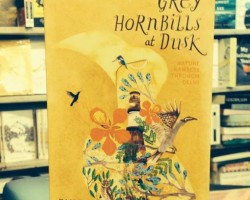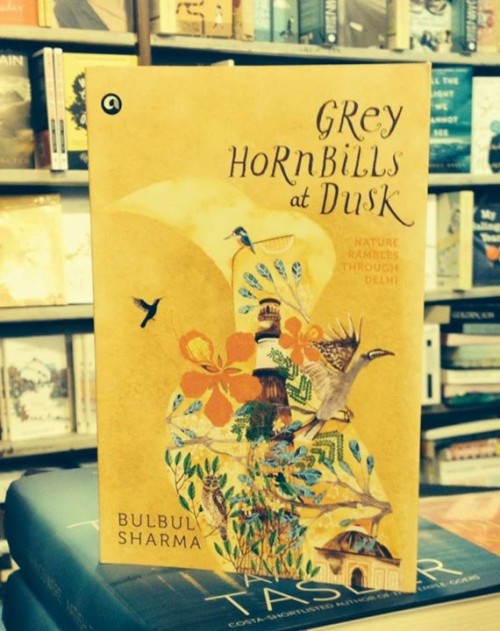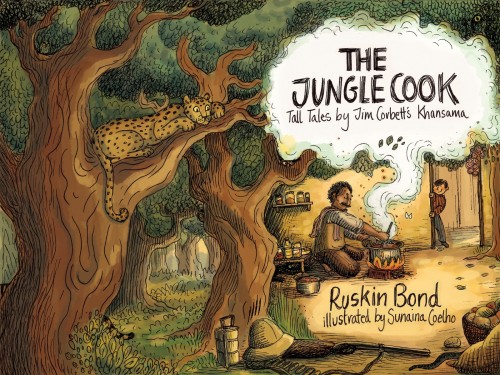Amrita Sharma reviews for India’s Endangered, Grey Hornbills at Dusk by Bulbul Sharma
Delhi is a truly fascinating city. It reflects the diversity of India where religions, languages, customs & cultures co-exist in a splendid plural harmony. Magnificent ancient monuments and architectural wonders, enchanting museums and art galleries, a scintillating performing-arts scene, exceptional eating places and vibrant and bustling markets. Delhi has them all. So, is it any surprise that Delhi boasts of an amazing range of avian diversity?
This polluted, claustrophobic and downright dirty metropolis hosts as many as 449 distinct species of birds amidst its many parks, ruins and gardens.
Delhi with its graceful old gardens and sprawling parks, unexpected patches of scrub forest and elegant avenues of old trees, has an amazing range of bird habitats. All you have to do is find a good spot with flowering shrubs or old trees and then wait to be entertained. The birds will arrive one by one and they do not care if you greet them or not…..
In her latest book “Grey Hornbills at Dusk”, Bulbul Sharma highlights Delhi as a veritable paradise for the urban bird watcher. By providing an account of Delhi’s resident and migratory birds, Bulbul Sharma not only opens a new perspective for her readers of observing their city, but also makes them a little bit more aware of the amazing gifts nature has given us. Its remarkable variety of habitats and species makes Delhi the perfect place for an introduction to birding. It takes little or no effort at all to become a bird watcher in Delhi, because the birds are right there in front of you at your very door step.
Birds have flocked to Delhi for hundreds of years to seek shelter, food and companionship and made it one of the best cities for bird watching in the world. There is no part of the city, however crowded, that does not contain at least a dozen different bird species on display at any given time. The narrow crowded lanes of Sadar Bazaar, one of the largest wholesale markets in Asia, will have mynas, sparrows and parakeets flying around shops. The ruined tombs on the outskirts of Delhi give shelter to many birds and the playing fields of various schools in Delhi have koels, parakeets, Brown Doves, Flame-backed Woodpeckers and many other birds sharing space with the children.
“Grey Hornbills at Dusk” is not a scientific guide to birds and trees. As an introductory book to bird watching, it is something more valuable than that. Bulbul Sharma has been an avid birdwatcher for the past 25 years and in this book she has distilled her delight and pleasure of bird watching in particular and observing nature in general. For any one embarking on the bird watching journey for the first time, it can serve as a handbook thanks to the comprehensive information about the various floras and fauna of Delhi provided here. But the task does not seem daunting thanks to the amusing and often hilarious anecdotes interspersed throughout the book. The anthromorphic narration of her encounters with various birds, bring them to life making the reader eager to seek them out and talk to them. Therein lays the success of the book.
The author’s passionate love for nature is contagious and as we explore every nook and cranny of Delhi, seeking out the elusive birds and delighting in what we find, some of her enthusiasm brushes off on us as well. Even if someone is not very interested in nature, “Grey Hornbills” will make a reader feel involved and just might evoke a desire to explore our wonderful world of nature.
The author has weaved in the nature related quotes and passages from folk lore as well as literary works by such authors as Kalidasa, Amaru and Kipling. This adds to the charm. So even if a person is not yet sold out to the cause of nature, this book would still prove an interesting read for a variety of reasons.
My only lament regarding this book is that it did not have enough pictures of birds. The words and description evoke such curiosity about the birds that one wishes to seek them out and see them. Had there been pictures too, the book would have become a Ready Recknor for a beginner bird watcher. The book does contain a series of pen and ink drawings of birds done by the author herself, and they are excellent by the way, but my complaint is that they are not enough. Here I must make a special mention of the book cover, which is a total delight to behold.
Since Delhi offers something interesting in every season, the book is divided into four sections, each corresponding to a season. I’ll let the author herself explain to you her reason for this format of the book.
Every season brings a new flavor to Delhi’s parks and gardens. Sometimes the change is so dramatic that you may not recognize a tree when it does a quick change t wear a different look for summer or winter. The laburnum, for instance, looks like a shabby, bad tempered tree in winter when it has no flowers. Its branches are covered with long brown sticks which rattle in the breeze like witches muttering curses. It does not care that the other trees like the Silk-cotton and the coral have brought out beautiful red flowers. It waits and watches and it knows, like the ugly duckling, it will change its form one day. Once the winter flowers fade and the Delhi spring arrives and is about to leave, making way for summer, the blossoms on the laburnum arrive slowly. And suddenly, one day, the tree becomes a fairy tale creature with streaming golden flowers-the magical yellow pyramid shimmering in the sunlight.
Delhi wears a beautiful cloak of verdant green during the rains, changes it for a thick shawl for winter and then quickly discards it for a lighter, cotton-shirt-look for the fierce summer. We, who live in Delhi, follow the rules and change our lives according to the seasons. If you spend a year in Delhi you will realize residents of the city are so tough and thick skinned. Unlike balmy Mumbai with its soothing sea breeze, hot and humid Kolkata with its delicious cool evenings and always tranquil Goa and Bengaluru, Delhi makes its residents struggle for a bit of warmth and then for a bit of cool shade.
There are rewards of glorious summer flowering trees, the crisp air of cold winter’s day or the scented nights of the rainy season. We complain as we shiver in the bitter cold, burn under a harsh summer sun, then gasp and sweat when the monsoon arrives, but there is the belief and beautiful Delhi spring which brings fragrant flowers, gentle sunshine and joy to our hearts.
This is a rather long excerpt. But this is my favorite passage from the book, as it not only made me fall in love with Delhi, but actually made me feel grateful for all Delhi has to offer us, if only we have the eyes to see.
Book Detail
Author – Bulbul Sharma
Publisher – Aleph Book Company
Price – Rs. 244 /-
Available in online bookstores at discounted rates,
Disclaimer:
The views expressed on this page are solely the reviewers’ and do not reflect those of various publishers, authors, publicists or agents. The book featured here was purchased by India’s Endangered for honest and independent review purpose only and is not part of any association with the author or publisher.
More Related Stories,
The Lonely Tiger – Book Review
The Wild Wisdom Quiz Book Review







3 thoughts on “Grey Hornbills at Dusk- Book Review”